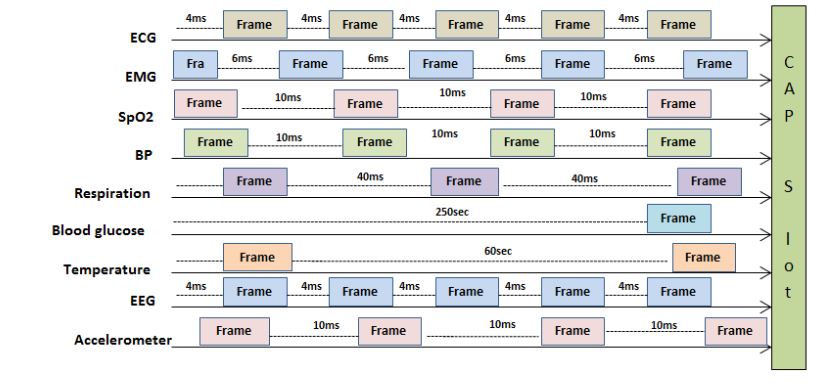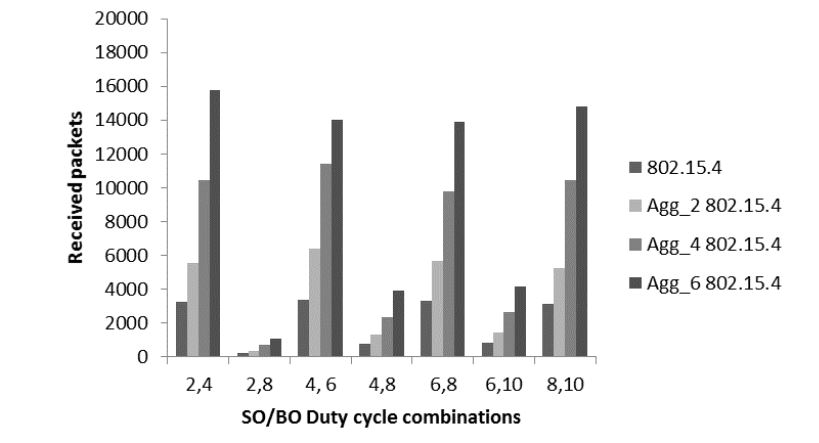ABSTRACT
In wireless body area sensor networks (WBASNs), Quality of Service (QoS) provision for patient monitoring systems in terms of time-critical deadlines, high throughput and energy efficiency is a challenging task. The periodic data from these systems generates a large number of small packets in a short time period which needs an efficient channel access mechanism.
The IEEE 802.15.4 standard is recommended for low power devices and widely used for many wireless sensor networks applications. It provides a hybrid channel access mechanism at the Media Access Control (MAC) layer which plays a key role in overall successful transmission in WBASNs. There are many WBASN’s MAC protocols that use this hybrid channel access mechanism in variety of sensor applications. However, these protocols are less efficient for patient monitoring systems where life critical data requires limited delay, high throughput and energy efficient communication simultaneously. To address these issues, this paper proposes a frame aggregation scheme by using the aggregated-MAC protocol data unit (A-MPDU) which works with the IEEE 802.15.4 MAC layer.
To implement the scheme accurately, we develop a traffic patterns analysis mechanism to understand the requirements of the sensor nodes in patient monitoring systems, then model the channel access to find the performance gap on the basis of obtained requirements, finally propose the design based on the needs of patient monitoring systems. The mechanism is initially verified using numerical modelling and then simulation is conducted using NS2.29, Castalia 3.2 and OMNeT++. The proposed scheme provides the optimal performance considering the required QoS.
RELATED WORK
MAC protocols have a vital role for the efficient functionality of WBASNs. The efficient MAC layer protocols for WBASNs have been a hot research topic for past few years. Aiming at provision of specified QoS in terms of delay, throughput, reliability and energy many efforts have been made to develop a new improved MAC protocol based on existing standards i.e., IEEE 802.15.4 and IEEE 802.15.6.
PROPOSED DESIGN

Figure 1. Channel access mapping of bio-medical devices for slotted CSMA/CA in a CAP slot
Figure 1 shows the scenario of channel access for a single CAP slot. The biomedical sensor devices generate frames according to their sampling interval shown in Table 3 and try to access the channel through contention mechanism of slotted CSMA/CA. When both modes i.e., CAP and CFP are used together then in the CFP mode GTS slots are assigned to important periodic data like ECG, EMG and EEG, whereas other nodes which require event bases or emergency data use the CAP mode.

Figure 5. Frame aggregation mechanism
This helps to reduce the overheads, i.e., the waiting time before a successful channel access and under utilization of the channel capacity. Figure 5 presents the frame aggregation mechanism in detail. As in a single channel, access multiple frames are transmitted which means we send multiple frames in the cost of a single frame overhead with lesser PHY header overhead. Moreover, aggregating the frame under a single PHY header almost fully utilizes the channel. In the following section, we present the proposed design and its evaluation and validation.
PERFORMANCE EVALUATION, ANALYSIS AND DISCUSSION

Figure 10. Received packets comparison
Figure 10 provides the received packets comparative analysis of 802.15.4 with the aggregated-802.15.4. The focus of evaluation is to explore the capacity of different level of aggregations. In the simulation, for aggregated-802.15.4, we used different frame levels including Agg_2 802.15.4 (two frames in an A-MPDU), Agg_4 802.15.4 (four frames in an A-MPDU) and Agg_6 802.15.4 (six frames in an A-MPDU).

Figure 12. Energy consumption analysis of aggregation with received packets
The scenario and parameters are the same as mentioned in Figure 12. It is observed that the energy consumption increases slightly by increasing the aggregation level but on the same time the average end-to-end delay significantly reduces and come under 250 ms which is recommended for bio-medical sensor devices in patient monitoring systems.
CONCLUSIONS
Aiming at patient monitoring applications of WBASNs, a frame aggregation mechanism has been proposed at the MAC layer in this paper to improve the channel access mechanisms as well as to meet strict time deadlines, provide reliable data delivery and fulfill energy efficiency requirements at the same time. For the patient monitoring system, we have selected ten different bio-medical sensor devices, including a coordinator and deployed them in a star topology. The devices include ECG, EEG, EMG, accelerometer, gyroscope, pulse oximeter, blood pressure, temperature, barometer and heart rate monitoring, etc.
The sensors periodically collect data from the body and send towards monitoring station through the coordinator node. The periodic, high prioritized and emergency data demand a different set of QoS when they are integrated in a patient monitoring system. To address the mentioned challenges, initially we have provided traffic pattern analysis of these devices to understand their communication requirements. From the traffic pattern analysis, it is observed that these biomedical sensor devices generate many small packets in a limited time.
The IEEE 802.15.4 standard supports the maximum frame size up to 127 bytes including 25 bytes of MAC header and 102 bytes of payload and a successful packet transmission involves the overheads like random backoff delay, two times CCA, 802.15.4 header with each frame, SIFS and acknowledgement transmission time. The maximum packet size from these bio-medical sensor devices used in the patient monitoring system is 17 bytes for a single frame including headers. Each frame contents the channel to send the data, so a node which wins the channel transmits a small packet and for the next packet transmission, it needs to content the channel again.
Therefore, on getting a channel, a node is under utilizing the available maximum packet size capacity which is 127 bytes for a MAC frame and only transmits up to 17 bytes. To address these issues, we have used the frame aggregation mechanism, which will send multiple MAC frames under a single PHY header within a single successful channel access. The concept of frame aggregation makes a huge difference in throughput and delay performance by efficiently utilization in channel access mechanism.
Source: Bournemouth University
Authors: Muhammad Sajjad Akbar | Hongnian Yu | Shuang Cang
>> More Wireless Sensor Networks Projects Abstract for Engineering Students
>> More Wireless Biomedical Projects for Engineering Students
>> More Wireless Energy Projects for Engineering Students
>> More Wireless Projects Implementation in Ns2 for Engineering Students